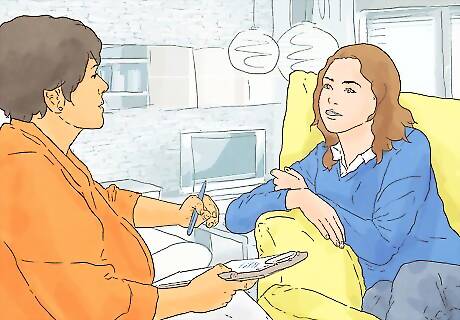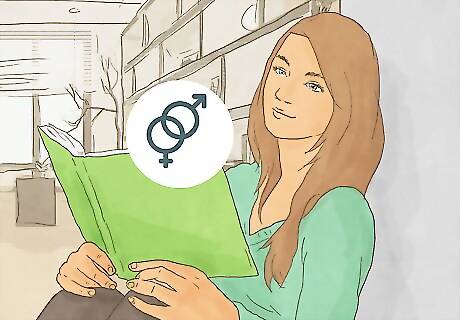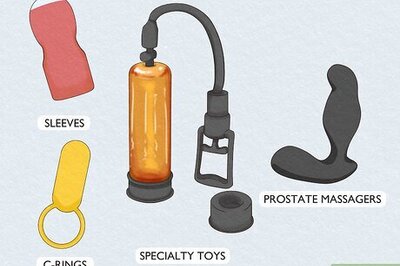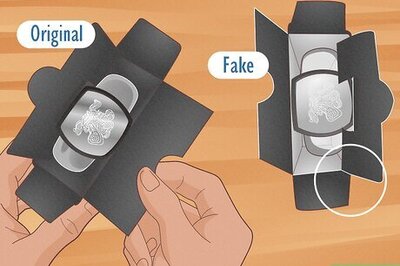
views
- Ask yourself if you feel physical attraction toward, or if you typically crush on, people of the opposite gender.
- Ask yourself which of your relationships feel most comfortable to you. Many straight people find it difficult to maintain platonic relationships with the opposite gender.
- Imagine yourself in sexual situations with people of the same and opposite gender and ask yourself which feels right to you.
Exploring Your Feelings

Determine whether you feel attracted to people of the opposite gender. Even if you have never had a romantic or sexual relationship with another person, you may have had feelings of sexual or romantic attraction toward other people. Think about people you have been attracted to, whether they are people you know personally, celebrities, or even fictional characters. If you find that all or most of the people you are/have been attracted to are of a different gender from you, there is a good chance you are straight.

Figure out whether you feel comfortable dating someone of the opposite gender. Think about your close relationships with others, whether they are platonic (just friends), romantic, or sexual. Take a moment to ask yourself how you feel about those relationships, without judging or over-analyzing those feelings. Consider which relationships have felt most comfortable (safe, fulfilling, happy) to you. Do you feel any romantic or sexual attraction toward your close friends of the opposite gender? If so, ask yourself how you would feel about dating any of those people. How do you feel about any romantic and sexual experiences you have had with people of the opposite gender, or with people of the same gender, if you’ve had them? Did you enjoy them and feel fulfilled by them? Make note of which relationships you feel the most positive about, and ask yourself how much the gender of the other person had to do with that feeling.
Examine your friendships. Many people are most comfortable being friends with people they aren’t sexually attracted to. For example, gay men tend to make friends with women more easily than heterosexual men do, while straight men might be more comfortable hanging out with other men. Think about your friendships. Are your relationships with people of the opposite gender often “complicated” by romantic or sexual feelings? Do you feel more comfortable being friends or hanging out casually with people of the same gender as yourself? If so, you may be heterosexual. Having a lot of friends of one gender or the other does not necessarily say anything about your sexuality. Look at your friendships along with other factors, like your romantic history or the types of sexual situations you like to fantasize about.

Use your imagination. Picture yourself in romantic or sexual situations with people of different genders. Let your mind take you where it wants to go without overthinking things or judging yourself. Think about how you feel when you imagine these situations: If you mainly enjoy imagining yourself with people of a different gender from yourself, you may be heterosexual. If you feel happy and excited when you imagine yourself exclusively in straight relationships or situations, then this may also be a sign that you are heterosexual.

Imagine yourself with different sexual identities. Sexual orientation is not black and white—it exists on a continuum. You may be straight, gay, or somewhere in the middle (bisexual or bicurious). Some people think of themselves as straight even if they occasionally feel attracted to (or have even had relationships with) people of the same gender, and some people consider themselves gay even if they have felt some attraction to/had relationships with people of another gender. Others are not interested in sexual or romantic relationships at all, with people of any gender. These people may consider themselves asexual or aromantic. What’s most important is how you think of yourself. Try writing down, or saying to yourself out loud, “I am heterosexual,” or “I am straight.” How do you feel when you refer to yourself this way? Does it feel comfortable to you?
Talking It Out

Talk to a close friend about your sexual orientation. Sometimes it can help to talk things over with someone who may be going through the same things and asking the same questions as you. Tell a friend you trust about the questions you have, and ask them about their own experiences, if they feel comfortable talking about it. If you know your friend is comfortable talking about their sexuality, try asking something like, “When did you first figure out that you are straight/gay/bisexual? How did you know?”

Find a forum where you can talk about sexual identity issues. Look for a moderated forum where you can talk (anonymously, if you prefer) with other people who are also looking for answers about their sexuality. If you’d rather not join the discussion, just reading other people’s conversations about the topic can be helpful. Try starting with the Sexual and Gender Issues forum at PsychCentral.

Talk to a counselor. If your questions about your sexual identity are causing you a lot of anxiety and stress, consider making an appointment with a mental health specialist (psychologist, clinical social worker, or counselor). They may be able to help you understand your sexuality better, or point you in the direction of some helpful resources.
Educating Yourself

Read books about human sexuality and sexual orientation. This can be a great way to understand your own sexuality better. If you are a teen or young adult searching for answers, you may wish to try one of these books: 100 Questions You’d Never Ask Your Parents: Straight Answers to Teens’ Questions About Sex, Sexuality, and Health, by Elisabeth Henderson and Nancy Armstrong, MD. S.E.X.: The All-You-Need-To-Know Sexuality Guide to Get You Through Your Teens and Twenties, by Heather Corinna.

Explore educational websites that address sexuality issues. Organizations dedicated to researching human sexuality and providing resources relating to sexual and reproductive health often provide free educational materials on their websites. Try exploring one of these websites to learn more about sexual orientation: Kinsey Confidential. This site is partnered with the Kinsey Institute, an organization dedicated to researching human sexuality. Read expert answers to sexuality questions, and submit your own questions anonymously. Planned Parenthood. In addition to providing care and education relating to reproduction and sexual health, Planned Parenthood also provides information about sexual orientation and gender identity: https://www.plannedparenthood.org/learn/sexual-orientation-gender American Psychological Association. The APA website provides plenty of in-depth information about sexual orientation and gender identity: https://www.apa.org/helpcenter/sexual-orientation.aspx

Take a class on sexuality. If you are in school, you may be able to sign up for a course on sexuality, or you may be able to sit in on a course at a local college. You may also be able to find free or affordable online courses about sexual identity. For example, check out the freely available online course materials for MIT’s introduction to Sexual and Gender Identities here: https://ocw.mit.edu/courses/womens-and-gender-studies/wgs-110j-sexual-and-gender-identities-spring-2016/



















Comments
0 comment